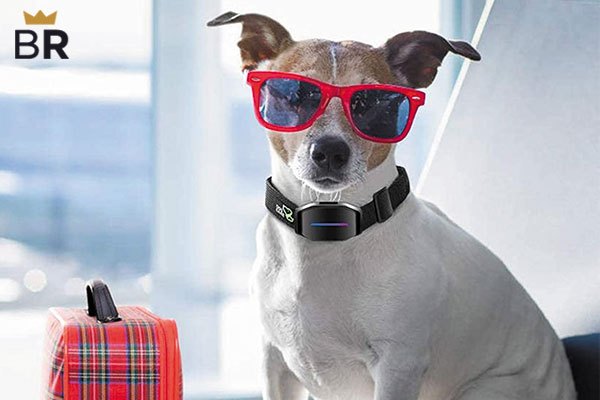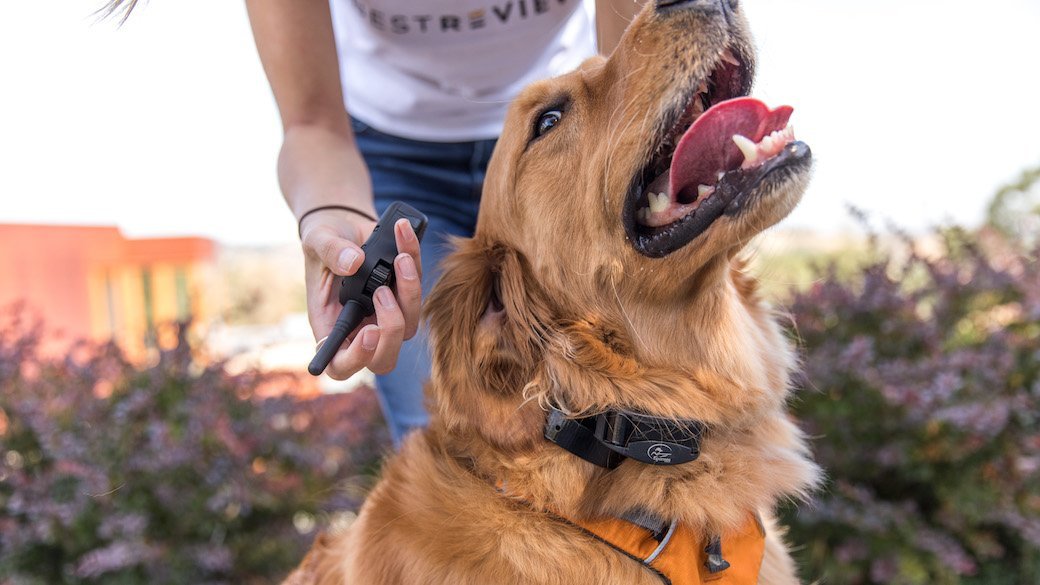

Control the 8 training modes that humanely vibrate, shock, or audibly control dogs without harming them.
The beeping, vibration, and shock modes all come with adjustable sensitivity. The modern tech inside it prevents false triggering. The smart design makes sure your dog stays under control while you are gone. One charge lasts up to 15 days.
Might not be ideal for large dogs. Buyers wish it allowed more customization between functions.
Best Bang for the Buck
A remote-operated shock collar designed to effectively train your dog and keep them safe.
Has a reflective collar and blinking lights, as well as shock, beeping, and vibration features. Great for big dogs. Owners said the collar was easy to use and easy to adjust to fit their dogs.
Reliant on a remote. Some buyers wished it had a larger range.

An expensive option but it has 100 levels of stimulation.
Suitable for any dog over 5 pounds. A 1/2 mile range and nighttime visibility for training at any time. Easy to add a second dog to the system. Intuitive remote.
Expensive. Might be too much for amateur trainers.

This waterproof dog collar with remote has 4 humane training modes: beep, shock, shock boost, and vibration.
The durable nylon strap adjusts to most dogs with necks from 8-25 inches around. Won't short-circuit when they run through rain or sprinklers. Remote works up to 2,680 feet. Got rave reviews from first-time dog owners and veterans.
The prongs that connect it fall apart too easily. Might not be ideal for especially large and feisty dogs.

This collar is reliable, functional, and has a number of great features.
Comes with a high-quality remote that is easy to navigate. Offers beep, vibration, and shock options that can be set to various levels of intensity. Is durable and waterproof and includes lights to keep your pup visible. Has a long range and strong vibrations.
A few remarked that the shock button is quite large and is easy to push accidentally.

BestReviews spends thousands of hours researching, analyzing, and testing products to recommend the best picks for most consumers. We only make money if you purchase a product through our links, and all opinions about the products are our own. About BestReviews
BestReviews spends thousands of hours researching, analyzing, and testing products to recommend the best picks for most consumers. We only make money if you purchase a product through our links, and all opinions about the products are our own. About BestReviews
BestReviews spends thousands of hours researching, analyzing, and testing products to recommend the best picks for most consumers. We buy all products with our own funds, and we never accept free products from manufacturers.About BestReviews
HOW WE TESTEDWe recommend these products based on an intensive research process that's designed to cut through the noise and find the top products in this space. Guided by experts, we spend hours looking into the factors that matter, to bring you these selections.
Click here for testing insights Models

Updated March 2023
Your dog may be the perfect four-legged companion in most situations, but if he has an excessive barking habit, it’s easy to get frustrated. Whether it’s because the UPS truck is making a delivery or a squirrel ran past your window, dogs typically don’t need much reason to bark, which is why a bark collar may be the only way to get some peace and quiet in your home.
A bark collar has a sensor to detect barking. When the collar senses that your dog is barking, it uses a correction to discourage the noise. This negative reinforcement trains your dog to stop barking because she learns to associate an unwelcome sensation or consequence with barking.
To make sure you train your dog safely and effectively, though, you have to choose the right bark collar. That means figuring out what type is best, the sensor type you prefer, and what other features will be most helpful in training your dog.


Most veterinarians only recommended the use of bark collars after you’ve tried other training techniques because it’s considered a more extreme measure.
Bark collars are available with several different types of corrective stimuli to discourage barking. While they can all be effective, you may be more comfortable using certain forms of negative reinforcement than others on your dog.
Most bark collars are designed to be effective on dogs of a certain size and weight. As with any collar, you have to choose a model that will fit the circumference of your dog’s neck. Measure your pet with a tape measure, and compare the measurement to the sizing guidelines. If the collar is adjustable, you can purchase a collar that’s slightly larger because you’ll be able to tighten it for a snug fit around your dog’s neck.
To make sure that a bark collar is both safe and effective, collars are often sold based on weight. That’s because a 10-pound dog obviously needs a milder pulse from a static collar than an 80-pound dog. Check the weight range listed for any bark collar that you’re considering to make sure that your dog can safely use it.


Static bark collars are designed to provide a shock through static electricity. We assess how safe this option is and if it can cause long-term harm to your dog.


The dog size can determine what type of bark collar you need. We look into a wide variety of products to see which ones work best in multiple scenarios.


Some dog collars work by creating stimulation for your dog that doesn’t hurt them, it merely makes them uncomfortable. This is something we consider during our evaluations.


Certain collars may recognize vibrations in a dog's vocal cords. We weigh the pros and cons of how well this type of sensor works for barking.


It is essential to have a bark collar that allows for sensitivity adjustment to protect your dog from injury. We vet each product to see just how adjustable this feature is.


Whether you have an outside dog or one that is simply messy when drinking water, it is best to have a waterproof collar to prevent injury. We assess each product to see if it is safely designed.


Some bark collars utilize batteries and some are rechargeable. We consider the pros and cons of each type to see which style would work best.


Some bark collars may come with a remote control to help with training. We take a deep dive into each product to see if it includes extra training materials.


Some unique bark collars may spray a fine mist to deter barking. We look into a wide variety of products to see how well they work to help train your dog.


Bark collars can run anywhere from $10-$265. We assess how many features each product has and if it is worth the cost.




















A bark collar has a sensor that determines when your dog is barking. Some collars have a vibration sensor, which picks up the vibration of a dog’s vocal cords, while others have a sound sensor that’s able to detect the noise of barking.
Vibration sensors may not be sensitive enough to detect all barking, while sound sensors may be too sensitive and trigger the collar when noises are detected around your dog. You can find some collars with dual sensors, which typically provide the most accuracy. Dual-sensor bark collars are more expensive, though.
No matter what type of sensor you choose, you should select a bark collar that allows you to adjust its sensitivity. The more sensitivity levels that a collar offers, the better you’ll be able to fine-tune the device so that it works only when your dog barks.
A bark collar’s sensor and behavior modification mechanism require some type of battery for power. Some collars use standard replaceable batteries, such as AAA or AA, while others feature rechargeable lithium-ion batteries that can last up to 70 hours without needing to be recharged.
Most pet owners find rechargeable batteries to be more convenient because you don’t have to run out to buy replacement batteries while you’re training your dog.
While bark collars are designed primarily to correct a dog’s barking problem, they can be used to train your dog to avoid other undesirable behaviors. To help you correct behaviors other than barking, some models allow you to trigger the collar with a remote control rather than waiting for the sensor to be activated. This feature may be ideal if you also want to discourage your dog from behaviors such as jumping on furniture or wandering away from your yard.
If you have an active dog, choosing a water-resistant bark collar can be an important feature. It allows the collar to still work effectively even if your dog is in the water, out in the rain, or getting bathed.
Did you know?If you use a bark collar with ultrasonic noise stimulation, be aware that other dogs in your house may be affected when the collar is triggered.
BestReviewsBark collars vary in price based on their sensors, sensitivity, and special features. Most collars range from $10 to $265.
The most affordable bark collars use a single type of bark deterrent and only offer up to 10 levels of adjustability. They usually run on replaceable batteries, have few special features, and cost between $10 and $65.
Mid-range bark collars typically offer two or more bark deterrent options and offer up to 50 adjustability levels. They usually run on rechargeable batteries, offer some special features like remote access, and cost between $65 and $170.
The most expensive bark collars offer three or more bark deterrent options and offer up to 100 adjustability levels. They run on rechargeable batteries, offer some special features like remote access and a waterproof design, and cost between $170 and $265.
Bark collars with only one stimulation level are often too extreme and may cause distress for your dog that makes training more difficult.
BestReviews

A bark collar typically won’t work to correct whining. That’s because the sensor usually can’t detect whining since barking reaches a different vocal pitch.
Q. Will a bark collar hurt my dog?
A. Even if you choose a bark collar that uses electrical pulses as a deterrent, it likely won’t hurt your dog. The pulses are designed to be mild, so they feel more like static electricity than a shock. If you’re concerned about your dog experiencing pain or discomfort, though, opt for a collar that uses vibration as a deterrent.
Q. Can my dog use a bark collar if he has health issues?
A. Most bark collars don’t have any health restrictions for use, but check the instructions. If you have any concerns about particular health issues that your dog suffers from, it’s best to consult with your veterinarian before using a bark collar.
Q. How long will it take a bark collar to stop my dog’s barking?
A. A variety of factors can affect how long it takes to train your dog not to bark with a bark collar. Your dog’s temperament, how frequently she experiences the stimuli that trigger barking, and how easily your dog is distracted while barking can all determine how long the training takes. In many cases, it only takes a handful of triggers from the collar for your dog to make the connection between barking and the deterrent, so you may see results in a week or so. Other dogs may need several weeks of training.